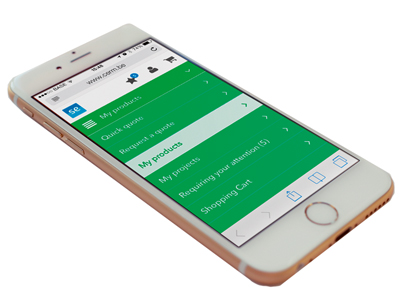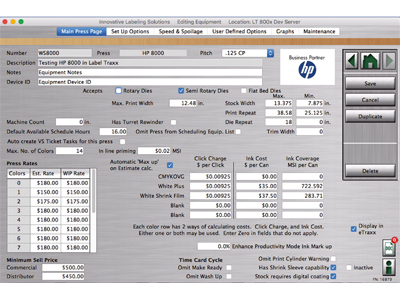Version 8 of Label Traxx MIS includes costing for the new HP Indigo 8000
There are many software tools developed especially for digital labels and packaging. Management information systems have made it easier to integrate with workflow and online web shop tools. The benefit is for workflow and administration automation, eliminating duplication of data entry and providing real time information for the converter and also the customer. By Sean Smyth.
Drupa offered glimpses of the next range of high performance presses that will advance the use of digital printing technology into corrugated, cartons, rigids and flexible packaging, as well as labels. These will open new opportunities for shorter runs and special versions, each requiring artwork and the associated administration to manage many more jobs. These changes require a new approach for companies that are used to managing a few large jobs each day, with new tools and methods.
The requirement to handle so many jobs adds a huge amount of complexity to a business. Each has to be loaded onto the production system, produced in pre-press, printing, finishing and despatched. Workload in administration and pre-press explodes to support the same volume of labels or packaging that fills the press. Trying to handle this volume without increasing the staff count is the key to successful operation. This change has occurred in the commercial print sector, where companies regularly handle hundreds (in some cases thousands) of jobs each day using web to print systems and automated workflow linked with their MIS.
Label workflows
In labels, Cerm and Label Traxx are the leading specialist MIS suppliers. Label Traxx has over 600 label converter customers using its industry-specific software, which is designed to streamline operations and offer faster and more accurate access to business data. It talks about converters becoming ‘data driven businesses’, using real information on which to base their important decisions. Version 8 of the software includes costing for the new HP Indigo 8000 press, allowing converters considering the press to use the cost model to analyse whether it will be a good fit for their business.
Other modules in v8 include an API module for sharing data with other systems, a new dashboard module for monitoring and managing key trends in the business and a Financial Center module for managing financial accounting within a multi-plant business. ‘The new module releases in Label Traxx reflect the global trend for immediate access to data and interconnectivity,’ explained commercial manager Jenny Whittle. ‘The most successful label companies will be the ones who have fast access to real-time data – and that might be across multiple software platforms. We are giving our customers the tools they need to stay ahead when running a modern business.’

Brand owners can upload artwork to Cerm MIS via the Web4Labels interface
Cerm is a narrow web specialist owned by Heidelberg, which also owns Gallus. It also supports the new 8000 press. Dutch printer Megaflex Bladel BV has been a Cerm user for several years and invested in the 8000. Director Bart van Limpt commented, ‘The implementation of Cerm software more than three years ago has allowed us to grow tremendously in terms of the number of orders we can handle, without adding staff in the customer service department. The market we serve increasingly requires a wider variety of printed products, smaller order quantities and shorter lead times.’ These are the common characteristics of digital production, and require a different approach to analogue production.
Interfaces are also available with Heidelberg Prinect, which drives the Gallus LabelFire 340 press, Hybrid Software and Screen Equios workflow amongst others. The upload of product artwork by brand owners in Web4Labels now has an integration with Chili Publisher.

Production scheduling in Tharstern MIS
Tharstern is another MIS supplier looking to reduce manual intervention across packaging workflows. It provides specific functionality for packaging companies and integration to CAD based systems, helping customers introduce automation, increase efficiency and improve margins. It has CRM and marketing tools to help packaging customers analyse trends and forecast future demand. This records information bespoke to each customer, highlighting key information that can be used to factor in things like seasonal trends. Tharstern software is based on SQL and web services, making it straightforward for other providers and developers to share data.
At drupa Konica Minolta joined forces with the company to demonstrate a fully integrated workflow from front end to output on the AccurioJet KM-1 inkjet press. Visitors could watch this in action with demonstrations from Vpress web2print and Tharstern MIS showing hybrid work and impositioning. Lee Ward, global sales director at Tharstern, said, ‘We wanted to show people what you can achieve when you take best of breed software and hardware and integrate them all together. The results were really very impressive.’
Low touch or no touch
Integration capabilities are vital in MIS, to develop efficient workflows with third party tools to automate repetitive production tasks.
One supplier is Enfocus, one of the pioneers in PDF pre-flighting. The PitStop product has developed to provide automatic error checking of PDF; in many cases it can fix a fault before it goes to press. Users set up the process parameters and then process files as they arrive. It can warn if low resolution images are detected, or identify an RGB image and can convert it into the correct profile process colour set. It can extend or add bleed to a PDF file. A missing font can be automatically embedded from the cloud using the Monotype Baseline service. It checks if white elements are set to overprint and can automatically set them to ‘knockout’ if wanted, and raises attention if transparency is detected to make sure it images correctly as the designer intended. Spot colours can be converted to CMYK and deep blacks can be set to the specific recipe for a particular printshop. PitStop Pro also lets users manually edit almost everything in a PDF file, while Switch is a configurable automation tool that enables file processing from receipt directly into a digital press queue. It uses hot folders to move and process files, and Enfocus is promoting its Appstore, a marketplace where Switch experts offer their expertise with new tools to solve problems and integrate production equipment and services.
Such approaches automate many aspects of production that previously required manual intervention, developing low-touch, or no-touch, workflows. The leading proponent is still Esko who provides packaging design and pre-press software and develops products throughout the supply chain to smooth all aspects of workflow. Each program is powerful in its own right, but when combined with the Automation Engine they become very powerful and productive tools that can be integrated with most MIS. The Automation Engine supports the changing role of the editor software into a checking and exception handling function, using the software to automate routine, repetitive tasks. Features put the emphasis on improving quality, using KPIs to track productivity, to provide a good project management toolset, triggering alarms and actions. This enables highly automated workflows in a global environment from centralised prepress workflows across multiple plant operations, or between brand owners and their printers.
At drupa, EFI showed a unified production ecosystem for packaging production featuring linked to the Esko Automation Engine to automate digital operations into a single, seamless workflow. This can include litho and flexo if they are used.
EFI is the world’s biggest supplier of print and packaging MIS, growing its business through a series of acquisitions that have consolidated the supplier base. It also provides front ends to drive many digital presses. At drupa it showed the new Fiery XB DFE platform for ultra high-speed presses, claiming full variable capability at speeds above 17,000 x A4 pages per minute.
There are several EFI Productivity Suites for specific workflows. They feature a core EFI MIS/ERP system combined with multiple integrated components to increase efficiency while allowing new revenue generation through a web portal. The Packaging Suite release has been expanded. It includes 22 certified workflows, providing administration and production automation for real-world label and package converting environments. The new Corrugated Packaging Suite delivers end to end corrugated board manufacturing solutions for box plants, sheet feeders and sheet plant printing workflows with support for the new inkjet Nozomi C18000 press.
Cloud-based tools
Several providers deliver solutions from the cloud. This means users always have the latest version of the software, and do not require investment in bespoke hardware.
EFI’s Fiery Navigator is the first release in a cloud platform for EFI technologies. It gives customers greater insight into their production data to optimise resource allocation, ensuring compliance with operating procedures and supporting smart equipment decisions. It captures key operational data points and displays production analytics for Fiery-driven printers in a comprehensive, customisable dashboard. As a result, users can identify opportunities to improve productivity, find potential cost reductions, and ensure the highest output quality in their digital print operations.
PrintOS from HP is another good example of the developing cloud-based systems. It is a print production operating system with a range of apps designed to help users get more out of their HP presses and printers, simplifying and automating production processes. Print Beat provides feedback on press/printer performance to drive continuous operational improvement. Media Locator helps improve print quality by selecting certified substrates and then downloading calibration settings directly to the press. The Substrate Manager helps ensure consistency across HP Indigo presses, and centrally manage and share properties for all substrates; while Knowledge Zone facilitates continuous learning with the latest news, technical information, and operator tips and tricks. Beyond HP technology, the system has solutions to simplify and automate print production.
Site Flow can manage any number of jobs per day – thousands if necessary – from submission to shipment, handling all production details. It simplifies and consolidates order capture from multiple sources, and streamlines communication with buyers. Box simplifies and enhances customer delivery of files with an automated, centralised and streamlined process including automated pre-flight. There are apps that enhance collaboration between print suppliers, such as Outsourcer, which enables companies to innovate and create new revenue streams. It can also integrate with customer systems to streamline ordering, job receipt and invoicing.
As digital technology grows in labels and packaging, converters are understanding the requirement to manage the workflow effectively. Adopting automation is the only way to control the costs associated with handling many more low cost jobs; working towards a no-touch workflow is a logical approach. It will save time, reduce cost and avoid errors. The management information system becomes a key source of competitive advantage in 2016.






